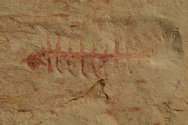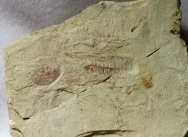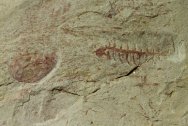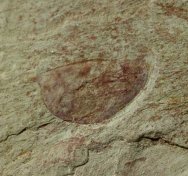Hallucigenia fortis
Phylum Lobopodia
Isoxys auritis
Phylum Arthropoda
Geological Time: Early Cambrian, (~525 million years ago)
Size (25.4 mm = 1 inch): Hallucigenia: 23 mm long; Isoxys 17 mm long by 8 mm across, on a 70 mm by 90 mm matrix
Fossil Site: Chengjiang Maotianshan Shales - Quiongzhusi Section, Yu’anshan Member, Heilinpu Formation, Mafang, Anning, Yunnan Province, China
Fossil Code: JH46
Price: Sold
|
The
Lobopodians are small marine and terrestrial animals termed colloquially “velvet
worms” or “worms with legs”. While all Recent
forms are terrestrial, most fossil Lobopodians are marine, and
are known The genus was first discovered in the slightly younger Burgess Shale of Canada (Hallucigenia sparsa), and was interpreted as walking on its spikes, rather than the legs as is quite obviously the case (perhaps the source of the genus name?). It is thought to be most closely related to Microdictyon, and may possibly be known from the Kaili Biota as well It is seen here in association with the bivalved arthropod Isoxys. The species is known mostly from the distinctively–pointed bivalved carapace as seen here. The taxon is only rarely preserved with any soft parts evident. Based upon the few known examples, it had a long segmented body, forwardly-projecting stalked eyes, and short antennae |






